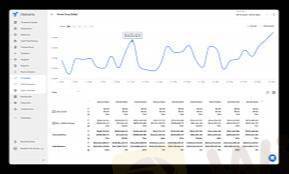
2025-04-28 12:50
IndustryPredicting mid-week reversals inforex pairs
#CurrencyPairPrediction
Predicting mid-week reversals in Forex pairs is a popular area of study for traders, as identifying these turning points can offer significant profit opportunities. Several technical analysis techniques and market patterns are employed to anticipate such reversals.
Price Action and Candlestick Patterns: Observing price action on lower timeframes around the middle of the week can provide clues. For example, the formation of reversal candlestick patterns like engulfing bars, pin bars (hammers or shooting stars), or doji at key support or resistance levels established earlier in the week can signal a potential change in direction. A decrease in momentum, as indicated by shorter price bars or divergence with momentum indicators, can also precede a reversal.
Technical Indicators: Various indicators are used to identify potential mid-week reversals. Oscillators like the Relative Strength Index (RSI) and Stochastic Oscillator can indicate overbought or oversold conditions, especially when divergence occurs with the price action. For instance, if a currency pair makes a higher high mid-week, but the RSI makes a lower high, it could suggest weakening bullish momentum and a potential reversal. Moving averages can also play a role; a break below a short-term moving average after a mid-week high, or a break above a short-term moving average after a mid-week low, can confirm a reversal.
Chart Patterns: Specific chart patterns that suggest reversals can form during the mid-week. Double tops or bottoms, head and shoulders patterns, and wedge formations that complete around Wednesday or Thursday can signal a change in the prevailing trend established at the beginning of the week. The confirmation of these patterns, such as a break below the neckline of a head and shoulders or a break out of a wedge, is crucial for increased confidence in the reversal prediction.
Time-Based Analysis: Some traders also look at time cycles and the tendency for markets to exhibit certain behaviors on specific days of the week. While not a definitive predictor, historical analysis might reveal a propensity for certain pairs to reverse direction around the middle of the trading week.
News and Events: Economic news releases or unexpected events occurring mid-week can act as catalysts for reversals. For example, a significant central bank announcement or a surprising inflation report released on Wednesday could trigger a change in the established trend for the week.
It's important to note that no single method is foolproof, and predicting mid-week reversals accurately requires a confluence of signals from various technical and fundamental factors. Risk management is also paramount when trading potential reversals, as these moves can sometimes be short-lived or fail to materialize.
Like 0
lake8359
Trader
Hot content
Industry
Event-A comment a day,Keep rewards worthy up to$27
Industry
Nigeria Event Giveaway-Win₦5000 Mobilephone Credit
Industry
Nigeria Event Giveaway-Win ₦2500 MobilePhoneCredit
Industry
South Africa Event-Come&Win 240ZAR Phone Credit
Industry
Nigeria Event-Discuss Forex&Win2500NGN PhoneCredit
Industry
[Nigeria Event]Discuss&win 2500 Naira Phone Credit
Forum category

Platform

Exhibition

Agent

Recruitment

EA

Industry

Market

Index
Predicting mid-week reversals inforex pairs
 Thailand | 2025-04-28 12:50
Thailand | 2025-04-28 12:50#CurrencyPairPrediction
Predicting mid-week reversals in Forex pairs is a popular area of study for traders, as identifying these turning points can offer significant profit opportunities. Several technical analysis techniques and market patterns are employed to anticipate such reversals.
Price Action and Candlestick Patterns: Observing price action on lower timeframes around the middle of the week can provide clues. For example, the formation of reversal candlestick patterns like engulfing bars, pin bars (hammers or shooting stars), or doji at key support or resistance levels established earlier in the week can signal a potential change in direction. A decrease in momentum, as indicated by shorter price bars or divergence with momentum indicators, can also precede a reversal.
Technical Indicators: Various indicators are used to identify potential mid-week reversals. Oscillators like the Relative Strength Index (RSI) and Stochastic Oscillator can indicate overbought or oversold conditions, especially when divergence occurs with the price action. For instance, if a currency pair makes a higher high mid-week, but the RSI makes a lower high, it could suggest weakening bullish momentum and a potential reversal. Moving averages can also play a role; a break below a short-term moving average after a mid-week high, or a break above a short-term moving average after a mid-week low, can confirm a reversal.
Chart Patterns: Specific chart patterns that suggest reversals can form during the mid-week. Double tops or bottoms, head and shoulders patterns, and wedge formations that complete around Wednesday or Thursday can signal a change in the prevailing trend established at the beginning of the week. The confirmation of these patterns, such as a break below the neckline of a head and shoulders or a break out of a wedge, is crucial for increased confidence in the reversal prediction.
Time-Based Analysis: Some traders also look at time cycles and the tendency for markets to exhibit certain behaviors on specific days of the week. While not a definitive predictor, historical analysis might reveal a propensity for certain pairs to reverse direction around the middle of the trading week.
News and Events: Economic news releases or unexpected events occurring mid-week can act as catalysts for reversals. For example, a significant central bank announcement or a surprising inflation report released on Wednesday could trigger a change in the established trend for the week.
It's important to note that no single method is foolproof, and predicting mid-week reversals accurately requires a confluence of signals from various technical and fundamental factors. Risk management is also paramount when trading potential reversals, as these moves can sometimes be short-lived or fail to materialize.
Like 0
I want to comment, too
Submit
0Comments

There is no comment yet. Make the first one.

Submit
There is no comment yet. Make the first one.